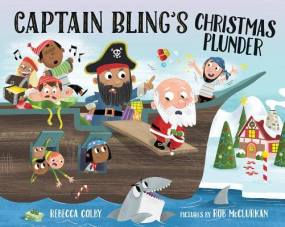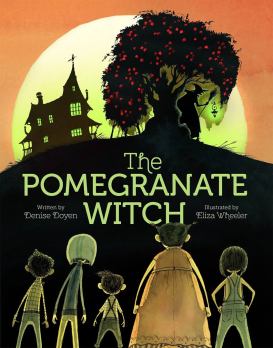
2017 TOP 10 List

CAPTAIN BLING’S CHRISTMAS PLUNDER
by Rebecca Colby
Illustrated by Rob McClurkan
CAPTAIN BLING’S CHRISTMAS PLUNDER by Rebecca Colby, Illustrated by Rob McClurkan:
Captain Bling and his merry crew set off to find treasure, but they get blown off course and end up at the North Pole. When they spy the elves carefully wrapping presents, the pirates think they have found the ultimate booty! They quickly steal the presents and make their way back to the ship. By the time Santa Claus catches up to them, the pirates are well on their way to escaping. But Santa has a surprise for Captain Bling and his crew!
What better Christmas gift than a rhyming picture book, combining pirates and the retelling of a classic Christmas poem? Author, Rebecca Colby had me hooked with her clever title, CAPTAIN BLING’S CHRISTMAS PLUNDER, and her interesting rhymes moved this story merrily along with several unexpected twists from Santa for Captain Bling and his crew.
- First, Rebecca, CONGRATULATIONS on being names as a Finalist for this year’s Best in Rhyme Award for CAPTAIN BLING’S CHRISTMAS PUNDER!! Combining Christmas and pirates is such a fun and unique mash-up! How did this concept first come to you and what was your goal for this story?
I love humor, and over the years I’ve discovered that one way to ensure a book is funny is to put two things together that aren’t normally found together. The contrast between two normally opposing things fuels humor—in this case, pirates and Christmas.
Every year I participate in Tara Lazar’s Storystorm (formerly PiBoIdMo). In 2014, when the event still took place in November, I decided to concentrate on coming up with as many mash-up ideas as I could. With it being the run-up to Christmas, holiday ideas featured heavily on my list.
My initial goal for the story was purely to write a humorous story. I knew from the beginning that the pirates would be naughty with a capital N, and seeking to steal Santa’s treasure of toys. But (spoiler alert here) I wanted the pirates to eventually have a change of heart. What I hadn’t worked out at that point was what the catalyst would be for their transformation.
- Your love of rhyme is obvious! How long have you been a rhymer and what has it taken to get both your rhythm and rhyme to this level of publishing perfection?
I seriously took to rhyme twelve years ago when my eldest child was a baby. I decided to embrace those long, sleepless nights she was gifting me with as an opportunity to write picture books and poetry.
When I first began writing in rhyme, my ex told me in no uncertain terms how bad my meter was. He suggested I either buy a metronome or give up on rhyme altogether.
Feeling confident in my rhyming skills, I refused to take on board his criticism until my local critique group told me the same thing, albeit in a more diplomatic manner. That’s when I started studying meter and began asking people to read my work aloud, so I could hear where the rhythm was off. Within a few short months, I had developed a much better ear for meter.
I should add, however, that this was still not the point at which my work came to “a level of publishing perfection,” as I was still using predictable rhymes and slant rhymes. What helped me most was studying books by other PB rhymers like Julia Donaldson.
- Also, how do you decide whether your story will be written in rhyme or not?
Good question! Very often I use traditional rhymes as patterns for my books, so I’ll have chosen a rhyme before I start to write. With Captain Bling, because I knew I was writing a Christmas story, I wanted to use the “Twas the Night Before Christmas” poem as my model. Had I not been able to make the story fit the rhyming pattern, I would have changed it to prose.
Before I get a reputation as only writing to traditional rhymes or songs, I should add that I’ve just sold a rhyming picture book that is not patterned after a traditional rhyme.
- What advice could you give to new or interested writers in Angie Karcher’s Rhyme Revolution group regarding writing in rhyme?
First and foremost, find some trusted critique partners. Angie’s Rhyme Revolution attracts rhymers from all over the world and, if they wish to be, she kindly connects them into critique groups. I’d definitely recommend taking advantage of this opportunity, as well as following Angie’s thorough and helpful posts each April, and reading and studying as many rhyming picture books as you can. Also, put a good rhyming dictionary on the top of your Christmas wish list!
- It’s exciting to see that you’ve traveled the world and currently live in the UK! How has that effected your picture book writing and please tell us about any impacts it may have also had on your US publishing and promotional aspects, as well.
I don’t feel my traveling and residence in the UK has adversely impacted on my being published in the US. I tried for years to get UK agents and editors interested in my work, and it was only when I gave up on the UK market and began submitting to the US market, that I realized, actually, my writing ‘voice’ was better suited for the US anyway.
As to promotional aspects, it’s harder to get festival and school events here as most of the organizers have never heard of me. Having said that, I’m pretty good at putting myself forward for events. I also produce free teaching resources for my books and am able to promote myself on-line to US librarians and educators that way. The only disadvantage I see is that I’m still waiting to be sent on a US book tour, but, I think that’s a pipe dream for many US-based PB authors as well, unless they write a bestseller.
- And finally, what’s next on your publishing path?
As mentioned above, I’ve just sold a further rhyming picture book, however, I’m not yet at liberty to disclose additional information about it. Other things I’m working on include a non-fiction book for adults, stand-up comedy sketches, and screenplays—none of which are in rhyme. Nothing may come of these other projects, but they keep me out of trouble and are allowing me to spread my writing wings, so to speak.
Thank you, Rebecca and much continued success!!

Rebecca is a children’s picture book author, poet, and screenwriter. Her children’s books are represented by Kathleen Rushall of Andrea Brown Literary Agency. Her fourth book, CAPTAIN BLING’S CHRISTMAS PLUNDER, was published by Albert Whitman & Co., 2017.
Buy It HERE
Rebecca’s other books include:
MOTOR GOOSE (Feiwel & Friends, 2017),
IT’S RAINING BATS AND FROGS (Feiwel and Friends, 2015), and
THERE WAS A WEE LASSIE WHO SWALLOWED A MIDGIE (Floris Picture Kelpies, 2014)
Congratulations REBECCA on
CAPTAIN BLING’S
CHRISTMAS PLUNDER
making the 2017 Best in Rhyme Top 10 List!







